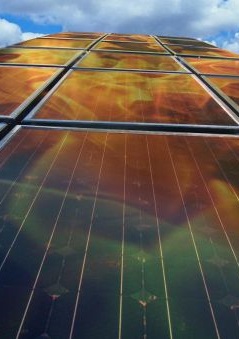More gains for future cells
 Australian experts have shown that next-gen solar panels can run cooler.
Australian experts have shown that next-gen solar panels can run cooler.
New studies show that singlet fission and tandem solar cells – two innovative designs to generate solar power more efficiently – also help to lower operating temperatures and keep devices running for longer.
Tandem cells can be made from a combination of silicon – the most commonly used photovoltaics material – and new compounds like perovskite nanocrystals, which help the device to capture more of the solar spectrum for energy generation.
Singlet fission, meanwhile, is a technique that produces twice the electronic charge carriers than normal for each photon of light absorbed. Tetracene is used in these devices to transfer the energy generated by singlet fission into silicon.
Scientists and engineers around the world are working on the best way to incorporate tandem cells and singlet fission processes into commercially viable devices that can take over from conventional, single junction silicon solar cells commonly found on rooftops and in large-scale arrays.
Now, researchers at the UNSW in Sydney have highlighted some key advantages to both tandem cells and singlet fission.
The researchers showed that both silicon/perovskite tandem cells and tetracene-based singlet fission cells will run at lower temperatures than conventional silicon devices.
This will reduce the impact of damage from heat on the devices, extending their lifespan and lowering the cost of the energy they produce.
For example, a 5 to 10°C reduction in module operating temperature corresponds to a 2 to 4 per cent gain in annual energy production.
Additionally, the lifetime of devices is generally found to double for every 10°C reduction in temperature. That means an increase in lifetime of 3.1 years for the tandem cells and 4.5 years for singlet fission cells.
In the case of singlet fission cells, there is another handy benefit. When tetracene inevitably degrades, it becomes transparent to solar radiation, allowing the cell to continue functioning as a conventional silicon device, albeit one that has initially operated at a lower temperature and delivered superior efficiency during the first phase of its lifecycle.
“The commercial value of photovoltaic technologies can be increased by either increasing the energy conversion efficiency or the operational lifespan,” says lead author Dr Jessica Yajie Jiang.
“The former is the primary driver for the development of next generation technologies, while little thought has been given to the potential lifespan advantages.
“We demonstrated that these advanced photovoltaic technologies also show ancillary benefits in terms of enhanced lifespan by operating at lower temperature and more resilience under degradation, introducing a new paradigm to evaluate the potential of new solar energy technologies.”








 Print
Print